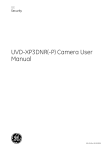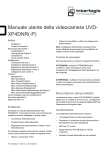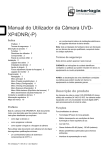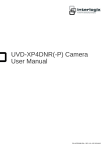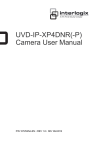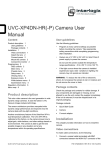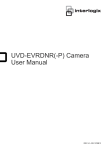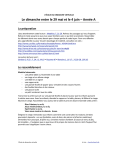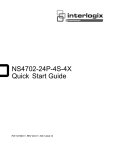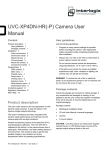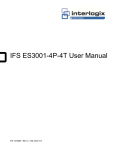Download UVD-XP4DNR(-P) Camera User Manual
Transcript
UVD-XP4DNR(-P) Camera User Manual Content Preface 1 Safety terms 1 Product description 1 Features 1 User guidelines 2 Components 2 OSD control pad 2 Installation 2 Cable connection 2 Camera installation 3 Angle adjustment 3 Focus adjustment 3 Connect the monitor 3 Programming 3 Navigation 3 Main menu 3 Presets menu 4 Setup menu 4 Viewing menu 6 Exposure menu 6 White balance menu 6 Save/restore menu 7 Contacting support 7 Regulatory information 7 Menu Map 8 • a basic knowledge of electrical wiring and lowvoltage electrical connections. Note: A qualified service person, complying with all applicable codes, should perform all required hardware installation. Safety terms These terms may appear in this manual: CAUTION: Cautions identify conditions or practices that may result in damage to the equipment or other property. WARNING: Warnings identify conditions or practices that could result in equipment damage or serious personal injury. Product description The UVD-XP4DNR(-P) (rugged dome) color video cameras is a 24 VAC/12 VDC model. The cameras are equipped with a digital signal processor (DSP) for processing the video signal. Preface Features This is the UVD-XP4DNR(-P) Camera. This document includes an overview of the product and detailed instructions explaining: Camera features include: • Next-generation XPosure technology. • how to connect the camera; and • Improved low-light performance and color balance. • how to program the camera. • 540 TVL lines color. • how to adjust the camera angle and focus • Dynamic range 95 dB (typical), 120 dB (maximum). • Preset modes optimized for various environments. • On-screen display interface. To use this document effectively, you should have the following minimum qualifications: • a basic knowledge of CCTV systems and components; and P/N 1079204A-EN • REV R1.0 • ISS 20DEC11 User guidelines Plug the monitor output RCA into the video monitor output and connect the monitor output BNC to the TV monitor. Use the following guidelines: • Program as many camera settings as possible before mounting the camera. Take appropriate safety precautions while completing programming after installation. • Always use a 12 VDC or 24 VAC UL listed Class 2 power supply to power the camera. • Do not use the camera outside the temperature range specifications: -57 to 122°F (-50 to +50°C). • OSD control pad The on-screen display (OSD) control pad (Figure 3) is a five-direction joystick that provides the ability to manually control the camera functions. Table 1 below lists the OSD control pad functions and describes their use. Figure 3: OSD control pad If the light source where the camera is installed experiences rapid, wide- variations in lighting, the camera may not operate as intended. WARNING: To reduce the risk of fire or electronic shock, do not expose the camera to rain or moisture and do not remove the cover or back. OSD control pad Components Table 1: OSD control pad controls Figure 1 shows the main components of the rugged dome unit. Figure 1: Rugged dom2e unit Lens body Pad directions Description Up Moves the cursor upward to select an item Left Moves the cursor left to select or adjust the parameters of the selected item. Right Moves the cursor to the right to select or adjust the parameters of the selected item. Down Moves the cursor downward to select an item. Enter Press the center of the control pad to display the Setup menu. If the selected item has its own menu, press the control pad to enter a submenu. Press the control pad for 2 seconds to save all settings and exit the Setup menu. Bubble Installation Camera body OSD control pad Video monitor output Figure 3 shows the monitor output components. This chapter provides information on how to install the camera and adjust camera angle and focus. To install the camera you will need to prepare the mounting surface, make cable connections, and mount the camera. Figure 2: Monitor output cable Cable connection To make cable connections, do the following: A. Monitor output BNC 2 B. Monitor output RCA 1. Connect a coaxial cable from the camera’s BNC connector to a CCTV monitor or video recording device. UVD-XP4DNR(-P) Camera User Manual 2. Connect a 12 VDC or 24 VAC power supply to the power input. The label on the camera gives the following information: Figure 5: Zoom and focus adjustment Red cable. Power in. Black cable. Power in. White cable. Video out. Black cable. Video ground. Zoom ring thumbscrew for VA2 and focus ring for VA9 lens Note: For AC24V or DC12V, Black or Red may be used for ground. Focus ring thumbscrew for VA2 and zooming ring for VA9 lens Camera installation Connect the monitor To mount the camera, attach the camera to the mounting surface using the appropriate fasteners. Program the cameras by attaching a standard video monitor to the system. To connect the monitor, do the following: Angle adjustment To adjust the horizontal angle of the platform up to 180 degrees, turn the platform (Figure 4). To adjust the horizontal angle of the rotor up to 350 degrees, turn the rotor on the platform (Figure 4). 1. Plug the monitor output cable (Figure 2) to the video monitor output connector (Figure 1). 2. Connect the BNC cable to the video monitor. 3. Press Enter (see OSD control pad on page 9) to display the Setup menu. To adjust the vertical angle of the platform up to 90 degrees, turn the platform (Figure 4). Programming Figure 4: Camera adjustment This chapter describes how to navigate the programming menus to adjust the camera settings. Platform horizontal adjustment Navigation Platform vertical adjustment Rotor horizontal adjustment Focus adjustment To adjust the camera zoom and focus, see Figure 5 and do the following: 1. Loosen the zoom ring thumbscrew. 2. Turn the zoom ring to set the desired zoom. 3. Tighten the zoom ring thumbscrew. 4. Loosen the focus ring thumbscrew. 5. Turn the focus ring to set the desired focus. 6. Tighten the focus ring thumbscrew. UVD-XP4DNR(-P) Camera User Manual To access and navigate the menus, press and hold the center of the OSD control pad (Figure 3). Press Up or Down on the control pad to move between items, and press Enter (center of the control pad) to select the item. Press Right or Left on the control pad to select the different options available for the item. You can return to the previous menu from any of the menus (except the Main menu) by selecting the Previous page option. Main menu The Main menu (Figure 6) provides the following options: • “Presets menu” en page 4. • “Setup menu” en page 4. • “Viewing menu” en page 6. • “Exposure menu” en page 6. • “White balance menu” en page 6. • “Save/restore menu” on page 7. 3 • Exit menu (exits the menu system). Figure 7: Setup menu There is a menu map provided on the back page of the manual. Figure 6: Main menu Camera ID setup menu The Camera ID setup menu (Figure 8) provides the following options: Presets menu • ID display (off or on). • Camera ID. Press Right to move the cursor to edit the camera ID. Press Up or Down to select the ID. When complete, press Up or Down to leave the editing field. • ID position (up-left, up-center, up-right, down-left, or down-left). The Presets menu options include: Normal. This is the camera default preset for general lighting conditions out of the box. This mode supports 14 bits of dynamic range and gives priority to rendering the highlights in the scene. Indoor. This preset supports 16 bits of dynamic range and gives priority to rendering the shadows in the scene. Figure 8: Camera ID setup Outdoor. This preset offers the highest dynamic range of 17 bits and gives priority to rendering the highlights in the scene. Flickerless. This mode uses line lock to eliminate phase roll under fluorescent lights. It must be used with a 24 VAC power supply. NTSC50Hz. This mode uses a DC iris lens to reduce phase roll under fluorescent lights. This mode will not function correctly with a manual iris lens. Setup menu Sync menu The Setup menu (Figure 7) provides the following options: The SYNC option in Setup menu (Figure 8 on page 19) provides the following INT or LL (LINE LOCK) options: • “Camera ID setup menu” below. • “Sync menu” below. INT. Internal sync. Used with DC power input to reduce the phase roll of fluorescent lights. • “Motion detection setup” on page 5. • WDR setup (safe area, center spot, lower 1/3, or full screen). 4 LL. Line lock. Used to sync video for AC power input so that the sync matches the frequency of the power input to eliminate the roll caused by fluorescent lights. (Figure 10) UVD-XP4DNR(-P) Camera User Manual Figure 9: Line lock menu Figure 11: Motion detection menu Motion detection setup A motion detection alarm refers to an alarm triggered when the camera detects a motion. The Motion detection setup display (Figure 10) provides the following options: • “Motion options” ci-dessous. • “Setup motion zone” ci-dessous Figure 10: Motion detection zone setup Motion detection menu The Motion detection menu (Figure 11 above) provides the following options: • Motion Threshold. Set the level of sensitivity of the motion detection. • Digital zoom. Determine how far in the camera zooms upon alarm. By default, the camera zooms to the center of the screen. • Digital pan. Adjust where the camera zooms upon alarm. Move the slider to the left to pan left, and to the right to pan right. • Digital tilt. Adjust where the camera zooms upon alarm. Move the slider to the left to tilt down, and to the right to tilt up. Setup motion zone Motion options The camera will monitor for motion in the area defined in the boxes defined in this submenu (Figure 12 below). When motion is detected in this area, the camera issues an alarm and zooms in. Off. Motion detection is disabled. Motion det. Motion detection is enabled, with default motion settings. Enter the submenu (Figure 11) to change the settings (see “Motion detection menu” below). When motion is detected, the word “Alarm” is displayed on the top left of the screen, and the image is zoomed, tilted, and panned to the area setup in Setup alarm zone. UVD-XP4DNR(-P) Camera User Manual Figure 12: Motion zone setup 5 Figure 13: Alarm zone setup Exposure menu The Exposure menu (Figure 15) provides the following options: To set up the alarm zone, do the following: 1. Choose one of the options Adjust Zone 1/2/3/4 from the Setup Motion Zone menu (Figure 12). The selected zone will have a thick border and be highlighted in white. Press the arrow keys to change the selected zone (Figure 13). • AGC (medium, high, custom, or low). The camera automatically adjusts the image quality in low light conditions. • AE preferences (highlights or shadows). • Range control (low, normal, high, or custom). • Shutter limit (x2, x4, x8, x16, x32, or off). A fast shutter speed captures clear images of fast action. • Frame RPT (OFF/ON). • B/W Control (OFF/ON). Figure 15: Exposure menu 2. Press Enter. The selected zone becomes green. Press the arrow keys to increase the zone area. 3. Press Enter. The selected zone becomes red. Press the arrow keys to shrink the zone area. 4. Press Enter for a few moments to leave the Alarm Zone Setup menu and return to Motion Zone Setup menu. Viewing menu The Viewing menu (Figure 14) provides the following options: • • Flip. (OFF, HORIZ, VERT, BOTH) Turn horizontal flip off or on. Resolution. (HIGH, NORMAL) High or normal. The High option over-sharpens the image for higher resolution. White balance menu The White balance menu (Figure 16) provides the following options: • Mode (ATW or PTL). ATW mode is automatic trace white balance. In PTL mode you can set a specific white balance. Figure 16: White balance menu Figure 14: Viewing menu 6 UVD-XP4DNR(-P) Camera User Manual Save/restore menu The Save/restore menu (Figure 17) provides the following options: • Save user settings. Saves all current changes. • Restore user settings. Discards all current changes. • Restore factory settings. Resets all settings to factory levels. • Regulatory information Copyright Trademarks and patents Manufacturer FCC compliance ACMA compliance Contacting support Table 2: Technical Support Europe, Middle East and Africa W Select Contact Us at www.utcfssecurityproducts.eu North America T +1 855.286.8889 E [email protected] Australia E UTC Fire & Security Americas Corporation, Inc. 2955 Red Hill Avenue, Costa Mesa, CA 92626-5923, USA Authorized EU manufacturing representative: UTC Fire & Security B.V. Kelvinstraat 7, 6003 DH Weert, The Netherlands Figure 17: Save/restore menu For contact information, see www.interlogix.com Interlogix, UltraView brand and logo are trademarks of UTC Fire & Security. Other trade names used in this document may be trademarks or registered trademarks of the manufacturers or vendors of the respective products. Reset camera. Resets the camera. For help installing, operating, maintaining, and troubleshooting this product, refer to this document and any other documentation provided. If you still have questions, contact us during business hours (Monday through Friday, excluding holidays). © 2011 UTC Fire & Security. All rights reserved. Canada Class A: This equipment has been tested and found to comply with the limits for a Class A digital device, pursuant to part 15 of the FCC Rules. These limits are designed to provide reasonable protection against harmful interference when the equipment is operated in a commercial environment. This equipment generates, uses, and can radiate radio frequency energy and, if not installed and used in accordance with the instruction manual, may cause harmful interference to radio communications. Operation of this equipment in a residential area is likely to cause harmful interference in which case the user will be required to correct the interference at his own expense. Notice! This is a Class A product. In a domestic environment this product may cause radio interference in which case the user may be required to take adequate measures. This Class A digital apparatus complies with Canadian ICES-003. Cet appareil numérique de la classe A est conforme à la norme NMB-0330 du Canada. Certification European Union directives N4131 12004/108/EC (EMC directive): Hereby, UTC Fire & Security declares that this device is in compliance with the essential requirements and other relevant provisions of Directive 2004/108/EC. 2002/96/EC (WEEE directive): Products marked with this symbol cannot be disposed of as unsorted municipal waste in the European Union. For proper recycling, return this product to your local supplier upon the purchase of equivalent new equipment, or dispose of it at designated collection points. For more information see: www.recyclethis.info. [email protected] Contact information For contact information see: www.interlogix.com or www.utcfssecurityproducts.eu. UVD-XP4DNR(-P) Camera User Manual 7 Menu Map 8 UVD-XP4DNR(-P) Camera User Manual








